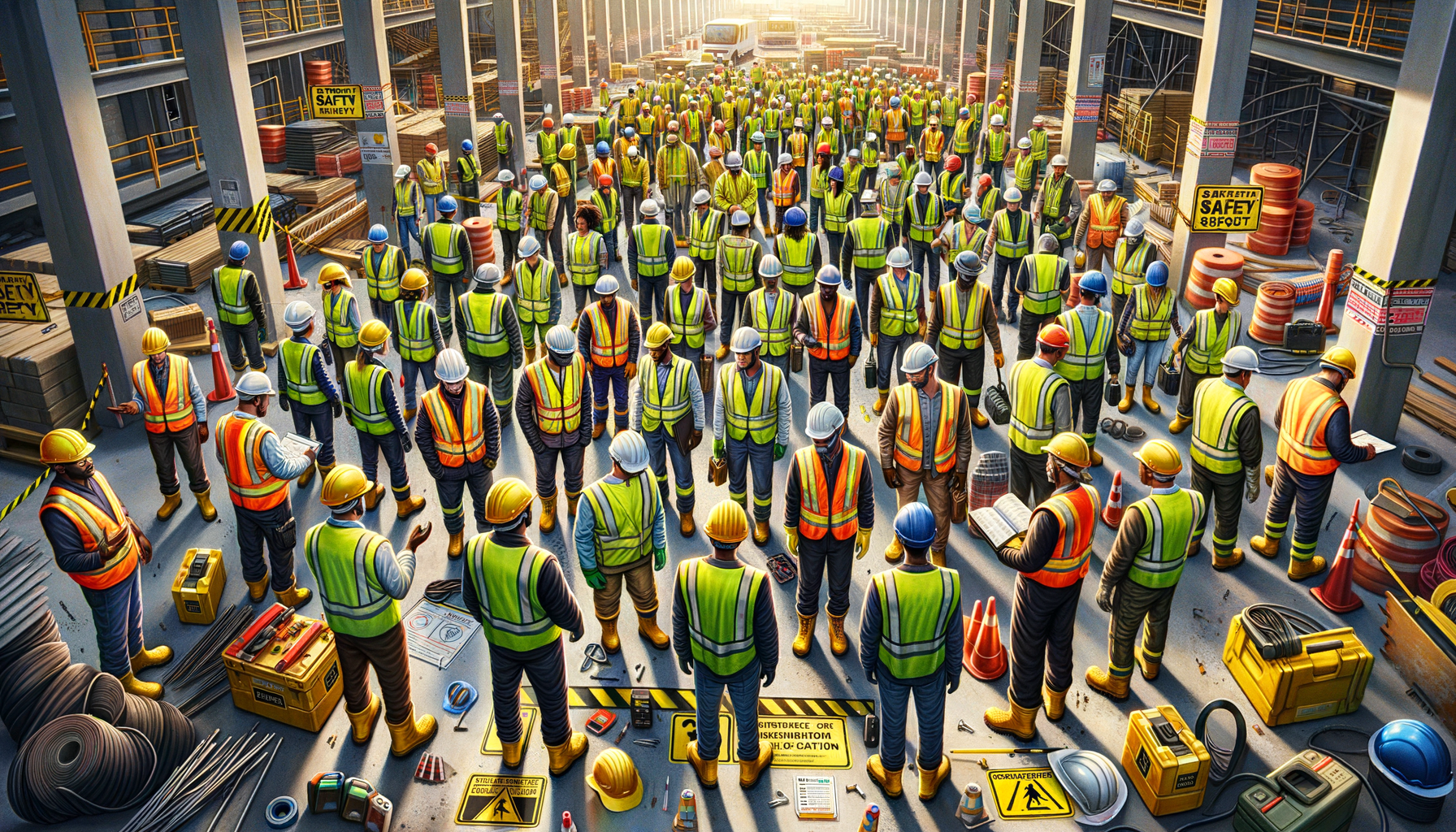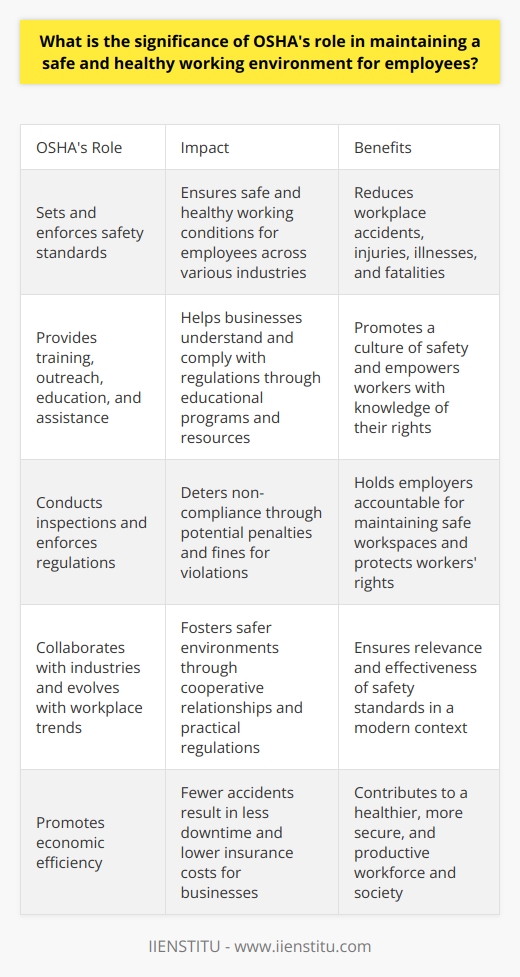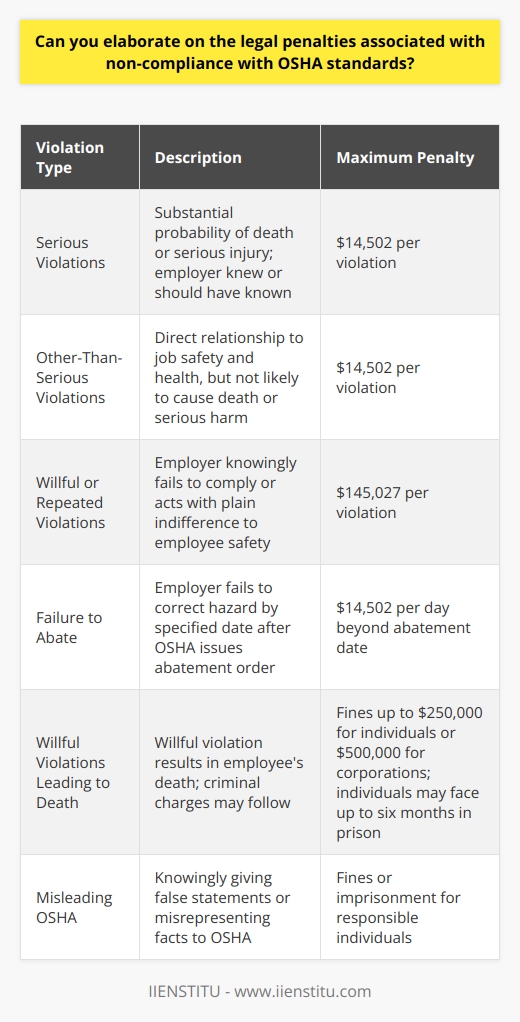
Understanding the mechanisms that safeguard the health and safety of employees within the dynamic ecosystem of the modern workplace is paramount. As we journey through the layers and functionalities of the Occupational Safety and Health Administration (OSHA), an entity at the forefront of worker welfare, we must acknowledge its historical progression, contemporary importance, and enduring commitment to ensuring a stringent yet supportive regulatory environment.
Understanding the Role of OSHA
The key to appreciating the scope of OSHA begins with an exploration of its primary roles and the multifaceted way it affects both employers and employees. Since its inception, OSHA has stood as the sentinel of workplace safety, tasked with formulating the blueprint for what constitutes a secure and healthy working environment across multiple industries.
Regulatory functions enacted by OSHA serve as the bedrock for maintaining workplace safety standards. With a vast repository of regulations that span various sectors, OSHA ensures that employers adhere to specific guidelines designed to minimize risks and prevent occupational accidents and illnesses. Enforcement is a crucial component, entailing inspections, audits, and follow-ups to guarantee that the letter of the law is converted into demonstrable practices on the ground.
Notably, OSHA does not cast its jurisdictional net indiscriminately. The administration's domain encompasses most private industries and some public sectors, engaging a broad spectrum of workplaces from construction sites to hospitals. Nonetheless, by delineating clear boundaries for coverage, OSHA tailors its protective scope effectively.
To concretize its protective mandate, OSHA establishes rigorous inspection protocols and delineates penalties for noncompliance to ensure adherence to its regulations. Employees benefit from this system not only in tangible security measures but also through inherent rights that empower them to demand safer working conditions without fear of retribution. Consequently, the presence of OSHA translates into a workplace invigorated by a culture of safety and shielded by a legal framework that promotes employee empowerment.
OSHA Standards and Compliance
Amid the labyrinth of OSHA standards lies the omnipresent General Duty Clause, a provision asserting that employers are obligated to provide a workplace free of recognized hazards. This clause symbolizes OSHA's adaptability and overarching reach, proving that even where specific regulations may not exist, the pursuit of safety remains unyielding.
Different industries encounter unique risks, necessitating tailored OSHA standards. In construction, for instance, fall protection paramountly minimizes the potential for lethal accidents. Meanwhile, manufacturing industries grapple with machine guarding to prevent traumatic injuries. This specificity underscores OSHA's meticulous attention to the diverse landscapes of labor.
The pathway to compliance is strewn with procedural steps designed to foster an environment consistent with OSHA's vision. A significant part of this involves meticulous reporting and meticulous record-keeping of workplace incidents, a process which both catalogs past accidents and prepares for proactive measures against future issues. For entities found in violation, OSHA elucidates a structured approach to rectify shortcomings, thereby reinstating the organization into the fold of safety adherence.
Case Studies of OSHA in Action
A review of OSHA's impact is not complete without a reflective examination of case studies where its influence has been markedly felt. Consider a manufacturing firm where the introduction of safety programs and adherence to the updated OSHA protocols led to a stark reduction in workplace injuries. Such success stories exemplify the tangible outcomes of earnest compliance with OSHA standards.
Conversely, the narrative of noncompliance is often fraught with legal repercussions, hefty fines, and, more importantly, the irreversible human cost of injuries or fatalities. A case involving disregard for OSHA's regulations leading to a tragic incident typically serves as an alarm for systemic change, with penalties often reinvested into improving workplace conditions and educating about safer work practices. These case studies become didactic tales reaffirming the significance of stringent compliance and continuous vigilance.
Navigating OSHA for Businesses
For businesses, the pursuit of OSHA compliance is a strategic imperative. It involves surpassing mere adherence to avoid penalties and embracing the ethos of safety as a core business value. Proactive steps must therefore be implemented to transcend the threshold of compliance toward a cultural veneration for employee well-being.
Understanding and effectively acting upon OSHA standards necessitate continual education and updated training. It is here that online certification courses become instrumental, serving both as an introduction for newcomers and a refresher for seasoned professionals. Introducing an hr certificate course tailored to OSHA compliance can unify HR professionals around the shared goal of workplace wellness, providing them with the expertise to implement OSHA prescriptions effectively.
Training and empowerment converge with OSHA's array of supportive resources. The consultation programs offer individualized advice to small and medium businesses seeking to better their safety protocols without the fear of penalties. Moreover, participation in OSHA's cooperative programs like the Voluntary Protection Programs (VPP) heralds a company's commitment to safety excellence, fostering a cooperative rather than punitive relationship with the administration.
The Future of OSHA
The trajectory of OSHA is an evolving narrative, with predicted changes and potential expansions that signal a future of more inclusive and rigorous safety standards. Technological advancements such as AI integration and increased automation in the workplace may necessitate a revamp of existing guidelines and the introduction of new ones.
The continuous adoption of improvements and compliant practices is not only beneficial for circumventing legal penalties but fundamentally serves the higher purpose of preserving human life and dignity. The march towards a future where occupational safety is interwoven with business operations requires the relentless pursuit of compliance, underscored by a principled commitment to fostering secure and healthful work environments.
In summarizing the role and impact of OSHA, one cannot overstate its pivotal function as a guardian of workplace safety and its embodiment as a catalyst for elevating standards of employee well-being. Businesses and employees alike are called upon to honor and uphold OSHA regulations, aligning mutual interests in the creation of a workspace where safety is not a byproduct but the cornerstone of operational excellence. As we chart the course ahead, let this steadfast adherence to OSHA principles define not just regulatory compliance but the moral compass guiding our collective endeavor in the workforce domain.
Frequently Asked Questions
What is the significance of OSHA's role in maintaining a safe and healthy working environment for employees?
Understanding OSHA
The Role of OSHA
OSHA stands for Occupational Safety and Health Administration. It emerged from the Occupational Safety and Health Act of 1970. Its primary goal is to ensure safe and healthy working conditions for men and women. OSHA sets and enforces standards. It provides training, outreach, education, and assistance.
Why OSHA Matters
Worker safety is non-negotiable. Unsafe work environments lead to injuries, illnesses, and deaths. OSHA's existence is crucial for prevention. The agency supports workers' rights to safe workspaces. It holds employers accountable for their responsibilities.
OSHA's Impactful Reach
OSHA covers most private sector employers and workers. It also extends to some public-sector employees. Its standards apply to a vast range of industries. This reach is significant. It ensures a wide impact on worker safety.
Safety Standards and Regulations
OSHA's standards are robust and comprehensive. They address specific hazards and general safety practices. Standards prioritize topics like fall protection, machine guarding, and hazardous chemicals. Companies must comply with these standards. Non-compliance leads to penalties.
Educational Programs and Resources
OSHA offers educational programs. These programs help businesses understand and follow regulations. Resources are available online and in person. They include fact sheets, training videos, and consultation services.
Enforcing Regulations and Penalties
OSHA enforces regulations through inspections. Inspections may be random or in response to complaints. Violations can result in hefty fines. Repeat offenders face escalating penalties. This enforcement deters non-compliance and promotes a culture of safety.
OSHA's Continuous Improvement
OSHA evolves with workplace trends and technologies. It updates standards and practices regularly. This ensures relevance and effectiveness. Worker safety in a modern context is OSHA's priority.
Collaboration with Industries
OSHA works with employers and industry groups. This cooperation helps to identify and mitigate risks. Collaborative relationships foster safer environments. Input from industries helps shape practical regulations.
Empowering Workers
OSHA empowers workers with knowledge. It provides them with rights to report unsafe conditions without fear. Workers can request OSHA inspections anonymously. This empowers employees to take an active role in their safety.
Reducing Workplace Accidents
OSHA's efforts have a direct effect on accident reduction. Statistics show a decrease in workplace fatalities and injuries since OSHA's inception. Its role is instrumental in this trend.
Economic Benefits
A safe workplace is also a cost-effective one. Fewer accidents mean less downtime and lower insurance costs. OSHA's role promotes economic efficiency by mitigating these risks. Its influence thus extends beyond just health and safety.
OSHA serves as the cornerstone of workplace safety in the United States. Its significance cannot be overstated. Through enforcing standards, educating stakeholders, and evolving practices, OSHA upholds the safety and well-being of the workforce. It ensures that safety is a right, not a privilege. The result is a healthier, more secure, and productive society.

How can a company effectively implement OSHA safety standards in their workplace?
Understanding OSHA Standards
Companies must prioritize workplace safety. OSHA stands for Occupational Safety and Health Administration. They set safety and health standards. Firms must comply with these standards. OSHA aims to prevent work-related injuries, illnesses, and deaths.
Developing a Safety Plan
Every company needs a safety plan. It should align with OSHA standards. The plan outlines safety policies and procedures. Companies must detail potential hazards. They should also include prevention strategies. Employee roles in safety must become clear.
Training and Communication
Training is key for OSHA compliance. Workers must understand safety procedures. Regular training sessions are essential. A variety of training tools can help. Examples include manuals, videos, and workshops.
Open communication fosters safety awareness. Regular meetings can address safety topics. Employee feedback is valuable. They see safety issues firsthand. Management should encourage an open-door policy.
Regular Inspections and Audits
- Conduct frequent workplace inspections.
- Use checklists to assess compliance.
- Identify and rectify potential hazards swiftly.
- Schedule regular audits for a thorough review.
These practices help pinpoint issues. They also reinforce a culture of safety.
Equipment and Facility Maintenance
Proper equipment maintenance is crucial. Machines should work correctly. This minimizes risk. Regular maintenance checks are necessary. Facilities must undergo frequent reviews. This ensures a safe environment.
Health Programs and Medical Surveillance
Health programs benefit employees. They promote wellness. Medical surveillance can detect ailments early. Such programs align with OSHA's goals. They aim to prevent occupational diseases.
Record Keeping and Documentation
Accurate records are fundamental. They must include injury reports and inspection logs. OSHA requires specific documentation. This holds companies accountable. It also helps track progress in workplace safety.
Involving Employees
Employee involvement is essential. Workers can join safety committees. They can take part in audits. Their participation improves overall safety culture. This also enhances compliance efforts.
Reviewing and Updating Safety Procedures
Safety procedures need regular updates. Risks change. So do regulations. Companies must adapt accordingly. They must remain vigilant. Staying informed on the latest OSHA updates is obligatory.
Seeking Professional Assistance
Expert advice can help companies. It ensures better compliance. Safety consultants offer valuable insight. They stay up-to-date with regulations.
Embracing a Safety Culture
Safety culture benefits everyone. It requires commitment at all levels. This culture reduces workplace accidents. It also promotes health and well-being.
Effectively implementing OSHA standards is multifaceted. It includes developing a strong safety plan and engaging in regular training and communication. Conducting inspections, maintaining equipment, and promoting health programs are also vital. Keeping thorough records, involving employees, staying current, and seeking professional advice support compliance and safety cultures. Companies achieve the best results by embracing these practices holistically.

Can you elaborate on the legal penalties associated with non-compliance with OSHA standards?
Understanding OSHA Standards
The Occupational Safety and Health Administration (OSHA) sets standards. These ensure workplace safety. Compliance is not optional but essential. Non-compliance attracts legal penalties. We explore these penalties and their implications.
Types of Violations and Associated Penalties
Serious Violations
A serious violation occurs when there's a substantial probability of death or serious injury, and the employer knew or should have known about it. OSHA's proposed penalty for serious violations can reach $14,502 per violation. Employers must address such hazards immediately.
Other-Than-Serious Violations
These violations have a direct relationship to job safety and health, but are not likely to cause death or serious harm. OSHA may still impose penalties up to $14,502 per violation. Workers' safety remains the priority.
Willful or Repeated Violations
A willful violation exists when an employer knowingly fails to comply or acts with plain indifference to employee safety. OSHA's maximum penalty for willful or repeated violations can mount to $145,027 per violation. Such negligence has no place in a safe workplace.
Failure to Abate
OSHA issues an abatement order when it identifies a violation. Employers must correct the hazard by a specified date. If they fail to do so, OSHA can levy penalties up to $14,502 per day beyond the abatement date. Time is of the essence in these cases.
Criminal Penalties
Willful Violations Leading to Death
If a willful violation results in an employee's death, criminal charges may follow. Convictions can result in fines up to $250,000 for individuals or $500,000 for corporations. Additionally, individuals may face up to six months in prison.
Misleading OSHA
Knowingly giving false statements or misrepresenting facts can lead to criminal charges. This deceit can result in fines or imprisonment for individuals responsible.
The Penalty Adjustment Process
Each penalty reflects the severity and type of the violation. OSHA considers several factors such as the business's size, the gravity of the violation, and the employer's previous history. A process of reduction may apply if an employer acts in good faith.
The legal penalties for non-compliance with OSHA standards are significant. They serve to promote a culture of safety and health. It is an employer's duty to adhere to these standards. Failure to do so can lead to substantial financial costs. It can also damage a company's reputation and, more importantly, endanger human lives. Compliance is not just a legal obligation but also a moral one.



